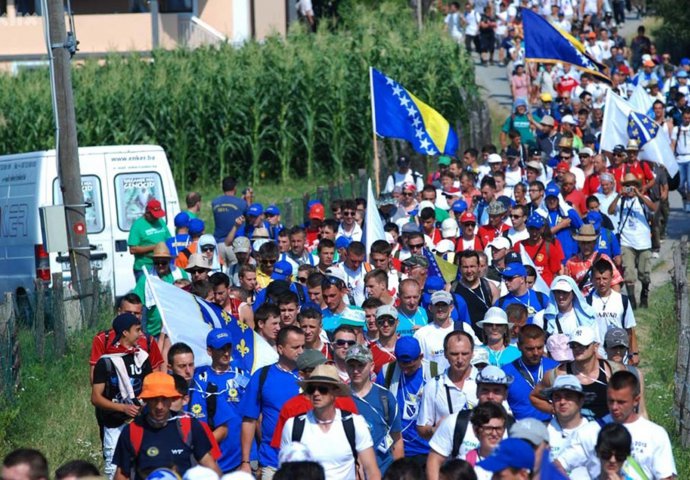Marš mira: An American Student’s Experience

On Friday, July 10, I marched the last leg of the Marš Mira, or the Peace March, that began many days before in Tuzla.
Marš Mira is a march that recreates, in inverse, the march of The Column, a group of some 15,000 people that marched from Srebrenica to Tuzla after the Serbian forces took the UN Safe Zone in 1995. The Column was subjected to Serbian sniper fire and land mines throughout the journey, resulting in the survival of only 3,500.
This year on the 20th anniversary of Srebrenica, an estimated 10,000 people took part in the march, and I was one of them.
I’ve spent the summer studying in Sarajevo at the American University of Bosnia and Herzegovina’s Peace and Conflict program, and everything I have learned from my professors (one of whom is the Srebrenica survivor Hasan Nuhanovic) prepared me for the historical background of Srebrenica.
Nothing prepared me psychologically.
Maybe it was the pair of shoes I stumbled over, covered in years of dirt, a pair I hoped wasn’t twenty years old.
Maybe it was the mass grave I passed, one that I know was twenty years old, even if the pair of shoes proved me wrong.
Maybe it was the “Attention: Mines” tape that flanked me and my 10,000 friends along the way, or the dichotomy of beautiful scenery against its tragic framery, or the weeping, broken faces of the Mothers of Srebrenica as we entered Potocari.
For some, I am certain, it was not my face they saw as I exited the forest.
As I stood over the empty graves patiently waiting for their eternal inhabitants (graves lined up as methodically as the shooting that demanded their existence), I thought about the many things I wished I didn’t know.
As an open pacifist, I wish I didn’t know about the hours of shooting, about the Bosniak whose skeleton was found in four different mass graves, or about the thousands who died on the same trail I had just traversed.
As a human being, I wish I didn’t know that, this far into the history of civilization, genocides still happen.
As an international community, we must recognize that the conceptual geography of genocide should not include denial (though, unfortunately, I fear that it always will). Russia’s veto of the recent UN resolution, in addition to Republika Srpska’s refusal of memorialization or recognition, are evidence of this. How can a country move forward when “genocide” is being removed from the few memorials allowed?
Even if we must resign ourselves to the existence of genocide denial, we must guard against allowing ourselves to engage in denial complicity, because in that, at least, we have a choice. Unlike intervention itself, which requires more complex arguments on a situational basis, denial complicity should not be fraught with the unfortunate divide that exists between morality and policy.
Lastly, we must acknowledge that the genocide in Bosnia was not limited to Srebrenica and Potocari, but, via intent by the aggressor, it existed everywhere from 1992-1995, and that every death should be mourned as such- and not just those that occurred on the fateful days following July 11, 1995. The pain from the killing of 8,372 should not obscure the pain of the single Bosniak death in a random village, simply because he or she did not have the privilege- if I may call it that- of dying in Srebrenica.
In short, tragedy in Bosnia and Herzegovina should never be condensed by the media as a game of “my horse is bigger than your horse,” because in the end, all murdered Bosniaks remain dead.
If there is one thing I have learned while I have been here, it is that division in Bosnia is still very much alive. But it occurs to me that division cannot be eliminated while blatant denial still exists. I have wondered often why the country is at such a deadlock and has been for so long. Walking with the aggrieved, however, answered in part the psychological aspect of that question.
How can a country move forward when the truth of half of its past is systematically erased and intentionally denied?
Khaled Hosseini taught me that there are a thousand tragedies per square mile. Walking through Bosnia I have seen that this is true.
In Potocari, there are 8,372 of them, and it is much less than a square mile.
If you count as a tragedy the reality that the genocide itself is not actually recognized as such, that count increases to 8,373.
That, I think, is the worst tragedy of all.
Kristina Drye (balkaninsight.com)